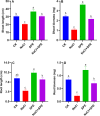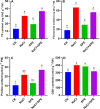Potential effect of non-nitrogen fixing cyanobacteria Spirulina platensis on growth promotion of wheat (Triticum aestivum L.) under salt stress
- PMID: 40781471
- PMCID: PMC12334567
- DOI: 10.1038/s41598-025-14567-y
Potential effect of non-nitrogen fixing cyanobacteria Spirulina platensis on growth promotion of wheat (Triticum aestivum L.) under salt stress
Abstract
Numerous microalgae have been used as modern eco-friendly biostimulants under abiotic stress conditions; however, the application of non-nitrogen fixing cyanobacteria, such as Spirulina (Arthrospira platensis) has not been extensively investigated. In this study, the effects of A. platensis (60 mg/L) applied twice as a foliar application on the growth, photosynthetic pigments, and oxidative metabolism of Triticum aestivum seedlings grown under salt stress (150 mM) were evaluated. Under salt stress conditions, growth attributes such as shoot and roots fresh weights, lengths, and photosynthetic pigments were significantly inhibited compared to the control group. Treatment with A. platensis effectively improved all growth parameters. Under salt stress conditions, shoot fresh weight and length increased by 49% and 44%, respectively, while root fresh weight and length were enhanced by 105% and 223%. The contents of chlorophyll a, b, and carotenoids in wheat were significantly reduced by 57%, 35%, and 43%, respectively. Additionally, seedlings exposed to salinity showed improved accumulation of hydrogen peroxide (H2O2) and malondialdehyde (MDA), along with decreased peroxidase (POD) enzyme activity. Spirulina extract (SPE) mitigated salt and induced oxidative stress by enhancing the activities of antioxidant enzymes. Furthermore, SPE protected wheat seedlings from the detrimental effects of H2O2 by promoting secondary metabolite biosynthesis. Additionally, SPE increased the proline content by 25%, aiding in the regulation of osmotic stress. Taken together, the results of this study support the application of A. platensis as an effective biostimulant for improving wheat growth and food security by reducing the harmful impacts of salt stress in semi-arid regions.
Keywords: Biostimulation; Crops tolerance; Cyanobacteria; Oxidative stress; Soil salinization.
© 2025. The Author(s).
Conflict of interest statement
Declarations. Conflict of interest: The authors declare no conflict of interest. Ethics approval and consent to participate: Not applicable. Consent for publication: Not applicable.
Figures








Similar articles
-
Enhancement of plant growth in lentil (Lens culinaris) under salinity stress by exogenous application or seed priming with salicylic acid and hydrogen peroxide.PLoS One. 2025 Jun 20;20(6):e0326093. doi: 10.1371/journal.pone.0326093. eCollection 2025. PLoS One. 2025. PMID: 40540484 Free PMC article.
-
Melatonin-Producing Bacillus aerius EH2-5 Enhances Glycine max Plants Salinity Tolerance Through Physiological, Biochemical, and Molecular Modulation.Int J Mol Sci. 2025 Aug 13;26(16):7834. doi: 10.3390/ijms26167834. Int J Mol Sci. 2025. PMID: 40869153 Free PMC article.
-
Effects of nitrogen on growth and physiological traits of feed mulberry under salt stress.BMC Plant Biol. 2025 Aug 2;25(1):1015. doi: 10.1186/s12870-025-07065-w. BMC Plant Biol. 2025. PMID: 40753184 Free PMC article.
-
Promotion of Ca2+ Accumulation in Roots by Exogenous Brassinosteroids as a Key Mechanism for Their Enhancement of Plant Salt Tolerance: A Meta-Analysis and Systematic Review.Int J Mol Sci. 2023 Nov 9;24(22):16123. doi: 10.3390/ijms242216123. Int J Mol Sci. 2023. PMID: 38003311 Free PMC article.
-
The Black Book of Psychotropic Dosing and Monitoring.Psychopharmacol Bull. 2024 Jul 8;54(3):8-59. Psychopharmacol Bull. 2024. PMID: 38993656 Free PMC article. Review.
References
-
- Sahab, S. et al. Potential risk assessment of soil salinity to agroecosystem sustainability: current status and management strategies. Sci. Total Environ.764, 144164 (2021). - PubMed
-
- Munns, R. & Tester, M. Mechanisms of salinity tolerance. Annu. Rev. Plant. Biol.59, 651–681 (2008). - PubMed
-
- Gonzales Cruz, C., Centeno da Rosa, A. P., Strentzle, B. R. & Vieira Costa, J. A. Microalgae-based dairy effluent treatment coupled with the production of agricultural biostimulant. J. Appl. Phycol.35, 2881–2890 (2023).
MeSH terms
Substances
Supplementary concepts
LinkOut - more resources
Full Text Sources

